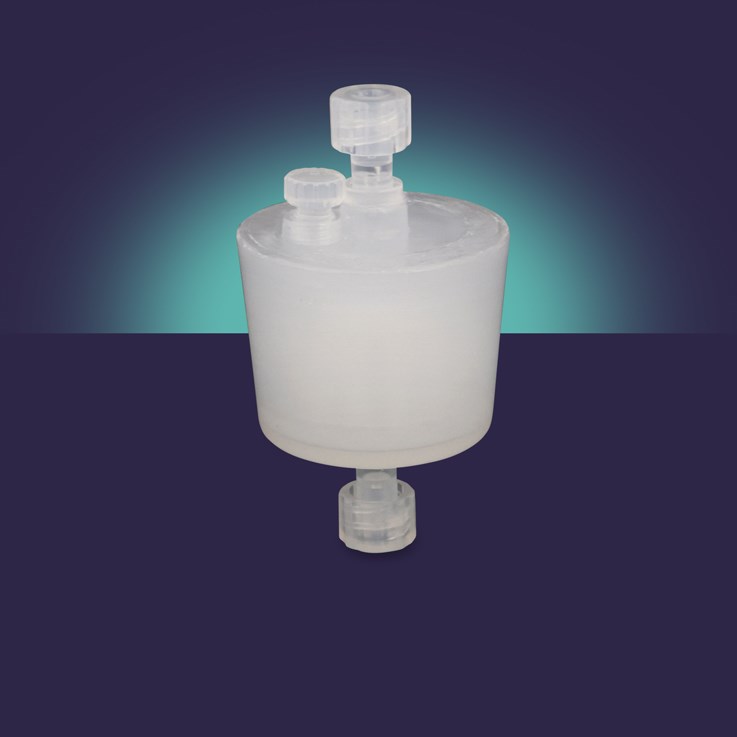Lentivirus
Lentiviral vectors (LVV) are crucial tools for cell and gene therapies, facilitating the direct delivery of anti-cancer agents to tumors and enabling adoptive immunotherapy with CAR-modified T cells. Purification of LVVs is vital to maximize therapy safety and efficacy. Gentle yet effective techniques are essential to preserve the yield and integrity of these fragile particles, ensuring maximum therapeutic impact.
Our solutions
LentiHERO® provides high recovery of purified LVV by guarding against unnecessary stresses, so particle degradation is minimized and LVV functionality is preserved. The purification process uses mild, low-salt conditions and low shear flow paths for high recovery at speed.
High viral vector recovery with LentiHERO® allows increases the full productivity of current feedstock batch sizes, thereby allowing a postponement of upstream scaling efforts. Maximizing viral vector recovery ensures optimal utilization of existing feedstock batch sizes. The LentiHERO® range includes devices for bench-scale and process development scales.
Shop the range
Key considerations for processing lentiviral vectors
Why is it important to consider the quality of LVV feedstock when preparing for downstream purification?
Biological assays inevitably incur a degree of variability. As many researchers experience large variability when characterizing biological batches of LVV and the TU assay, we recommend performing loading experiments and optimization in triplicate.
What conditions do you recommend for endonuclease treatment for the reduction of nucleic acid levels?
To reduce host cell nucleic acid levels, we recommend 50 units of endonuclease per mL with 2 mM MgCl2 for at least 1 hour at 37°C.
What are the recommendations for primary clarification of LVV feedstock?
For primary clarification, we recommend centrifugation, or a depth filtration step with a pore size of 1 µM, followed by a 0.45 µM PES filter.
Is it necessary to perform a loading study?
To get the best performance from the primary capture step, it is strongly recommended to conduct a loading study for any new adsorbent or feedstock.
What are the key considerations for a LentiHERO® adsorbent loading study?
- Aim to load 5E+9 to 1eE+10 TU per mL of LentiHERO® adsorbent. Collect fractions at 1/10 of total load volume and analyze each fraction.
- It is preferable to measure functional particles in the flowthrough if that assay is available. Alternatively, calculate the physical titer using qPCR for genome copies, or with a p24 assay. Be aware that free p24 may break through immediately, so adjust the breakthrough capacity accordingly, accounting for the initial P24 amount.
- A calculated process load should be 80% of the total TU value where 10% of the functional particles breakthrough. Process recovery should be measured from the elution pool of this process load.
What approaches can be used to optimize the elution buffer?
- We have observed that functional particles of LVV elute earlier from the LentiHERO® than from commercially available Q membranes.
- As a reminder, the most relevant measure of recovery is the functional assay. The ratio of functional particles to physical particles should improve in the elution pool.
- Since different pseudotypes and payloads or genes of interest (GOI) can influence the particle’s surface charge—and thus the conductivity at which the LVV elutes— we recommend conducting an initial study with stepwise elution to establish the appropriate elution range. Collect each step immediately into a diluent to achieve a final concentration of 200 mM NaCl in the final pool.
Example of elution buffer optimization study: |
Step | Volume | Elution buffer | Dilution |
Elution 1 | 15 Bed Volume | 200 mM NaCl 20 mM Tris 20 mM MgCl2 pH 7.5 | |
Elution 2 | 15 Bed Volume | 600 mM NaCl 20 mM Tris 20 mM MgCl2 pH 7.5 | 1 in 3 volumes of 20 mM Tris, pH 7.5, 20 mM MgCl2 |
Elution 3 | 15 Bed Volume | 1 M NaCl 20 mM Tris 20 mM MgCl2 pH 7.5 | 1 in 5 volumes of 20 mM Tris, pH 7.5, 20 mM MgCl2 |
Strip | 15 Bed Volume | 2 M NaCl 20 mM Tris 20 mM MgCl2 pH 7.5 | 1 in 10 volumes of 20 mM Tris, pH 7.5, 20 mM MgCl2 |
Should further optimization of elution, and the ongoing stability of viral vector through buffer exchange and formulation for fill and finish be required, these aspects of the process can be explored by adjusting the elution or dilution buffer composition. Consider the following suggestions:
- Lowering elution pH to 6.5-7 (e.g., by using BTP at pH 6.5, or HEPES at pH 6.8 for the elution buffer), since the weak anion exchange of the LentiHERO® allows elution at even lower conductivity at lower pH.
- Screening additives to increase freeze-thaw stability (e.g., sucrose or trehalose up to 10%).
- Matching the dilution buffers for the elution buffer, but raising the pH to 7.5, and matching the additives to achieve a final concentration of 10% of the sucrose or trehalose.
Further reading on LVV processing
- Lentiviral Vector Bioprocessing, C. Perr, Viruses, 2021; 13(2): 268. doi: 10.3390/v13020268
- Advances in Lentivirus Purification, A. Moreira, Biotechnol. J., 16: 2000019. doi: 10.1002/ biot.202000019
How many repeats are recommended to assess the purification of LVV?
By quality we are referring to the ratio of physical titer to functional titer. Larger volumes of a lower quality feed, i.e. where the physical particle titer is very high compared to the functional particle titer, will be required to load the appropriate number of functional particles onto the chromatography adsorbent. As a result, it is important to consider the feedstock quality to ensure that the volume of feed available for characterization is adequate. As a result, it is important to consider the feedstock quality to ensure that the volume of feed available for characterization is adequate.
Brochures
User Guides
Posters & Graphics
Videos
Articles
Blogs
Any questions?
Request a follow-up and one of our experts will contact you directly:









